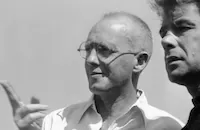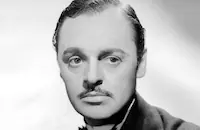The Saint Strikes Back

Brief Synopsis
Cast & Crew
John Farrow
George Sanders
Wendy Barrie
Jerome Cowan
Jonathan Hale
Neil Hamilton
Film Details
Technical Specs

Synopsis
Private detective Simon Templar, known as "The Saint," becomes entangled in an investigation of a major San Franciscan crime ring headed by an elusive character known only to the police as Waldeman. When a gang murder occurs at the Colony Club on New Year's Eve, it triggers the flight of Val Travers, the daughter of a police inspector who committed suicide after his humiliating discharge on suspicion of being a member of Waldeman's gang. Val, who has organized a gang of second-rate hoodlums to ferret out the mysterious Waldeman and thus exonerate her father, runs into Templar as she tries to elude the police. When the San Francisco police department sends for Inspector Henry Fernack of the New York City police department to help with their investigation, Fernack forms an uneasy alliance with Templar. At police headquarters, Templar hypothesizes that Travers was framed by an inside man at the police department, but his theory is ridiculed by criminologist Cullis, who suggests that Templar is Waldeman. Learning that the murdered man was to have met Martin Eastman, a well-known philanthropist, Templar breaks into Eastman's safe, where he finds a stack of federal bank notes that have been stolen by Waldeman's gang. When Eastman fails to report the robbery but visits Cullis instead, Templar suspects that Cullis and Eastman are in league with Waldeman, but the police are unable to arrest them for fear of losing Waldeman. To flush out Waldeman, Val and Templar visit Eastman's house, where Templar has secretly returned the bank notes. Faced with the stolen notes, Eastman panics and runs from the house, where he is shot. Templar and Val next pay a visit to Cullis and confront him with the incriminating notes, forcing him to confess that he framed Val's father. Unknown to Cullis, the police have installed a dictaphone in his office and are listening to his confession. When Cullis accuses Templar of being Waldeman, the police commissioner announces that Templar has been working with the police from the begininng, and Cullis finally admits that Allen Breck, Val's meek legal advisor, is the elusive Waldeman.

Director

John Farrow
Cast

George Sanders

Wendy Barrie

Jerome Cowan

Jonathan Hale

Neil Hamilton

Barry Fitzgerald
Robert Elliott

Russell Hopton
Edward Gargan
Robert Strange

Gilbert Emery

James Burke

Nella Walker
Crew
Albert D'agostino
Edward Donahue
A. C. Edington
Jack Hively
Lee Marcus
Van Nest Polglase
Frank Redman
Renie
Robert Sisk
John Twist
Roy Webb
Earl A. Wolcott

Videos
Movie Clip


Film Details
Technical Specs

Articles
The Saint Strikes Back
The first screen version was The Saint in New York (1938), with Louis Hayward as the titular hero. George Sanders then took over the role for The Saint Strikes Back (1939) and brought his particular brand of aloof sophistication to four more Saint films over the next two years. He was succeeded by British actor Hugh Sinclair, who carried the franchise for two more installments in 1941 and 1943, when RKO discontinued the series. It was ten years before another Saint movie appeared, with Louis Hayward returning to the role. That one was not a success, and Simon Templar disappeared until the 1960s when he was revived first in France (once by Jean Cocteau's actor-muse-lover Jean Marais) and then, most famously, by Roger Moore in a long-running TV series and movie spin-offs, a rehearsal of sorts for Moore's later work as 007. Another series hit British TV in the late 70s, and the character's final appearance to date was a 1997 version of the tale with Val Kilmer as the Saint.
The dense, intricate plot of The Saint Strikes Back involves a disgraced policeman's daughter, a stolen $80,000 and confusion over just who is or is not on the side of the law, creating a gripping mystery and a huge hit for RKO. The convolutions of the script were well crafted by the appropriately named John Twist and directed with style by John Farrow, husband of Maureen O'Sullivan (aka Tarzan's Jane) and father of Mia Farrow. An urbane, accomplished man who was also a writer, Farrow began directing programmers before moving on to bigger budget films. He received a New York Film Critics Best Director award, as well as an Academy Award nomination, for his war film Wake Island (1942), and won an Oscar® (shared with S.J. Perelman and James Poe) for the screenplay of Around the World in Eighty Days (1956), for which he also fulfilled some uncredited directing duties.
After leaving the Saint behind, George Sanders went on to create a similar character, the Falcon, in a hit that spawned another series. Joining him in this venture was his co-star in this movie, Wendy Barrie (who appeared in several Saint movies back to back, though oddly never as the same character). He made four Falcon movies before passing the baton, in The Falcon's Brother (1942), to his own real-life brother Tom Conway. Although never in the top ranks of stardom, Sanders contributed many fine performances in notable films and won the Best Supporting Actor Oscar® as the cynical, acid-tongued critic Addison DeWitt in All About Eve (1950). Bored with life and the world, he committed suicide in Barcelona in 1972, an act he had pledged to do years earlier.
Early publicity about this production noted that Fredric March and Joan Fontaine were set to play the roles taken by Sanders and Barrie. Charteris had always lobbied for his character to be played by the likes of Ronald Colman, Cary Grant or Douglas Fairbanks, Jr., and felt that both Hayward and Sanders were "hopelessly miscast." He was far more pleased with Roger Moore's image and interpretation.
Director: John Farrow
Producer: Robert Sisk
Screenplay: John Twist, based on the novel Angels of Doom by Leslie Charteris
Cinematography: Frank Redman
Editing: Jack Hively
Art Direction: Van Nest Polglase
Original Music: Roy Webb
Cast: George Sanders (Simon Templar, aka The Saint), Wendy Barrie (Val Travers), Jonathan Hale (Inspector Fernack), Jerome Cowan (Cullis), Barry Fitzgerald (Zipper Dyson).
BW-64m.
by Rob Nixon

The Saint Strikes Back
Quotes
Trivia
Notes
The working title of this picture was The Saint Strikes Twice. It was the second in RKO's "The Saint" series, and marked George Sanders debut as the title character. For more information about the series, consult the Series Index and see entry above for The Saint in New York.














